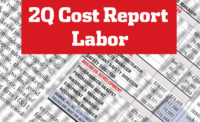The fate of federal spending legislation, dubbed the Build Back Better Act, is in doubt after Sen. Joe Manchin (D-W.Va.) publicly announced his opposition on Dec. 19. In its current version, the bill could result in added financial incentives for contractors, while imposing potential costs in the form of new penalties and fines.
In an evenly split Senate, Manchin’s vote, along with every other Democrat, is needed to pass the $1.75-billion bill, now in the reconciliation process,
The bill’s current version may not gain enough support as written, but Democratic leadership is not ready to declare its demise. “We are going to vote on a revised version of the House-passed Build Back Better Act, and we will keep voting on it until we get something done,” stated Senate Majority Leader Chuck Schumer.
"I still think there’s a possibility of getting Build Back Better done," President Joe Biden said in a Dec. 21 news briefing.
What does and does not make it into future bill versions is a mystery, but any provision opposed by Manchin is likely to be cut, says Peter Comstock, Associated Builders and Contractors senior director. “For [Senate Democrats] to get anything done, it will have to be on Manchin’s terms,” he says. “Whether or not progressives and the White House can go along remains to be seen, but that’s what is needed if they are to rescue the president’s major priority for next year.”
One provision Manchin has openly opposed is family medical leave, which would potentially affect many construction employers, if enacted. He has largely expressed concern over costs impacts on taxpayers, but some industry groups are concerned over costs employers may incur.
“CIVIL PENALTIES FOR SOME LABOR ACT VIOLATIONS PROPOSED FOR THE FIRST TIME ARE VASTLY OUT OF LINE WITH EXISTING PENALTY STRUCTURES.”
— JAMES YOUNG, AGC SENIOR DIRECTOR
James Young, an Associated General Contractors senior director, says one provision could add, for the first time, civil monetary penalties for violations of the National Labor Relations Act—$50,000 per occurrence, and up to $100,000 if repeated.
It is “vastly out of line” with existing labor penalty structures, he says. “These should … be debated on the floor, not stuck into a 2,000-page bill.”
Comstock says these penalties could be applied to violations that “do not specifically harm” employees. “It could just be an employee handbook violation,” he says. “While that is something that should be remedied, no one is harmed. He wants “a more facilitative relationship with the National Labor Relations Board to modify or fix these problems.”
The bill’s call for a more than five-fold penalty hike in some OSHA violations “represents bankruptcy inducing levels of penalties that would hit smaller firms the hardest,” he adds.
Enforcement would also gain more resources under the current bill. Young says roughly $2 billion is allocated for enforcement activities by federal safety, labor and equal employment agencies. The White House is “looking strictly at enforcement, not to encourage compliance or employer outreach.”
The bill does provide some boosts to construction, including $134 billion in tax incentives targeted at construction of renewable energy infrastructure.
But Young says to be eligible, contractors would have to meet 15% registered apprenticeship goals. Comstock says ABC is concerned about the ability of all contractors to meet those requirements, adding that it would be “the first time for extending those types of labor mandates to privately financed work.”
Overall, Comstock says that many provisions in the current bill could add up for some contractors.
“It’s a death by a thousand cuts for small business,” he says. “From the taxes to the additional fines to the regulatory requirements. You’re placing more burden on employers. They’ve already been hard hit by COVID and many are still struggling.”
.jpg?1640294268)




Post a comment to this article
Report Abusive Comment